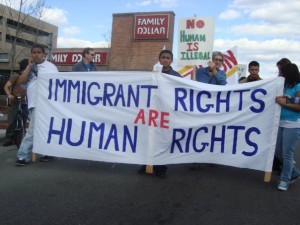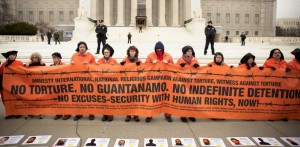GTMO in MSP
04 July 2014 – Evan Taparata
Guantanamo Public Memory Project, projects, advocacy, social justice, public engagement, human rights
Editor’s Note: This piece continues a series of posts related to the Guantánamo Public Memory Project, a collaboration of public history programs across the country to raise awareness of the long history of the US naval base at Guantánamo Bay (GTMO) and foster dialogue on its future. For an introduction to the series, please see this piece by the Project’s director, Liz Ševčenko.
Before his inauguration and during his first moments in office, President Barack Obama pledged that his administration would pass significant immigration reform to reduce deportations and provide a pathway to citizenship for undocumented migrants, as well as close the prison at the US Naval Base in Guantánamo Bay. Yet in the last six years, while Republicans in Congress have repeatedly blocked immigration reform from being passed, President Obama’s administration has overseen the deportation of a record number of migrants from the United States—two million and counting. Guantánamo, meanwhile, remains in active service, with 149 individuals detained there as of June 2014.
Skyrocketing rates of immigrant detention and deportation and the continued operation of Guantánamo may seem to be only tangentially related. But the apprehension of suspected terrorists and attempts to deport immigrants have similar consequences—individuals being forcibly removed from their homes, from their families, and from their communities to be detained for prolonged periods of time, waiting, while US authorities determine their fate.

Ramsey County Adult Detention Center in St. Paul, MN. Photo credit: The World Association, Inc., Gruzen & Partners
With several immigrant detention centers located in the Minneapolis-St. Paul metro region and throughout the state of Minnesota, my colleagues and I at the University of Minnesota sought to explore the relationship between Guantánamo and the Twin Cities by creating a digital project to accompany the Guantánamo Public Memory Project. Titled “GTMO in MSP,” our project—which remains an ongoing work-in-progress—is an online exhibit that utilizes a multi-tiered timeline to document immigrant detention in Minnesota along with increased surveillance of the Somali American community in Minneapolis since 9/11.
GTMO in MSP argues that migrant detention and surveillance of immigrant communities in Minnesota is, like Guantánamo, entangled with the history of US interventions abroad and the nation’s ongoing pursuit of its national security interests (it is no coincidence that US Immigration and Customs Enforcement has been subsumed under the Department of Homeland Security since the beginning of the “war on terror”). GTMO in MSP curates examples of migrant policing and detention from the recent past to explore how the tactics used to detain suspected terrorists have had actual consequences in Minneapolis and St. Paul.
The human costs of migrant detention and deportation are not foreign to Minnesota. Just as Haitian and Cuban refugees held at Guantánamo in the early 1990s[1] and current detainees have faced deplorable conditions while held in US custody in Cuba, migrants in the custody of US Immigration and Customs Enforcement in Minnesota have also been treated harshly. A Somali asylum seeker detained at the Sherburne County Jail who was shot by a deputy with a stun gun began to suffer from incontinence, impotence, mental trauma, and blackouts after the incident. A Somali woman charged with deportation, also detained at Sherburne County Jail, was refused the right to wear her hijab despite assurances that she would be permitted to freely practice her religion while in custody. Detainees at Guantánamo recently went on hunger strike, meanwhile, to protest indefinite detentions, poor conditions at the base, as well as policies that permit Guantánamo officials to search through inmates’ Korans for contraband.
The impact of conditions on detainees’ health has been a consistent concern in Minnesota’s detention facilities. A woman detained at the Ramsey County Jail while awaiting deportation proceedings, for example, claimed to suffer from severe headaches after her arrest, yet was denied medical attention; she died hours later. US Immigration and Customs Enforcement has reported that from October 2003 to December 2013, approximately 140 individuals died in ICE custody. Since Guantánamo was opened and as of April 2013, nine detainees have died there. The last detainee to pass away at Guantánamo was never charged for any crime. The ongoing surveillance of Muslim communities, meanwhile—alleged by some elected officials to be an essential arm of national security efforts despite the fact that such surveillance constitutes a violation of civil liberties—continues to disrupt the everyday lives of innocent people who are routinely subject to suspicion of wrongdoing in Minneapolis, New York City, and other cities throughout the country.
These and other events that we’ve included in GTMO in MSP tell a non-linear historical narrative that encourages users of the project to explore the linked histories of Guantánamo and MSP. Just as the GPMP encourages the public to consider how the deeply rooted history of Cuba-US relations offers important context for the continued operation of the US Naval Base at Guantánamo, GTMO in MSP encourages visitors to the site to consider, for example, how increased policing of immigrant communities within the United States is bound up with the privatization of the prison industrial complex, along with subsequent revisions to immigration law in the 1990s that substantially expanded the definition of a deportable offense and required migrants to be held in detention centers while awaiting deportation.[2] By bringing together in one place many different examples in which Twin Cities immigrant communities have had to cope with detention, deportation, and surveillance, GTMO in MSP echoes the Guantánamo Public Memory Project’s efforts to promote dialogue among the public about the far-reaching effects of Guantánamo’s history both before and after 9/11.

Activists on Lake Street, Minneapolis, MN. Photo cCredit: Labor Rights Blog
Specifically, GTMO in MSP hopes to encourage sustained and critical dialogue about what is at stake in the use of detention, deportation, and surveillance as tactics to pursue US national security in Guantánamo and beyond. It is a dialogue that has been long underway. In Minnesota, the Minnesota Immigrant Rights Action Committee, the Immigrant Law Center of Minnesota, and the local state chapter of the Interfaith Coalition on Immigration have been vocal opponents of policies that perpetuate unjust detention and deportation policies. These groups—like those who have mobilized in support of closing Guantánamo—have protested that immigrant detention and deportation violate human rights and international law.

Protesting human rights violations at Guantánamo. Photo credit: Amnesty International
Earlier this year, my colleagues and I participated in a public forum held at the Brian Coyle Center in Minneapolis to discuss how several of the phenomena associated with the US Naval Base at Guantánamo Bay, Cuba, have come to have an impact on the Twin Cities metro area. On June 23, the traveling exhibit of the Guantánamo Public Memory Project was displayed on Capitol Hill in Washington, DC, as part of an effort to continue discussions about the future of the US Naval Base in Cuba. It will be worthwhile for these ongoing conversations to take into account how the normalization of indefinite detention at places like Guantánamo has enabled impacted practices of detention, deportation, and migrant policing throughout the United States more broadly.
~ Evan Taparata is a doctoral candidate in History at the University of Minnesota-Twin Cities. In addition to participating in the Guantánamo Public Memory Project, his research focuses on how the US government sought to regulate internal and international refugee migration in North America from 1800 to 1924.
[1] For more information regarding the treatment of Haitian and Cuban refugees at Guantánamo, see A. Naomi Paik, “Testifying to Rightlessness: Haitian Refugees Speaking from Guantánamo,” Social Text 104 28.3 (2010): 39-65; Karma R. Chávez, “ACT UP, Haitian Migrants, and Alternative Memories of HIV/AIDS,” Quarterly Journal of Speech 98.1 (2012): 63-68; and Elizabeth Campisi, “Guantánamo: Safe Haven or Traumatic Interlude?” Latino Studies 3 (2005): 375-392.
[2] See Kelly Lytle Hernández, “Amnesty or Abolition? Felons, Illegals, and the Case for a New Abolition Movement,” Boom: A Journal of California 1.4 (2011): 54-68 and Mark Dow, American Gulag: Inside US Immigration Prisons (Berkeley: University of California Press, 2004).



